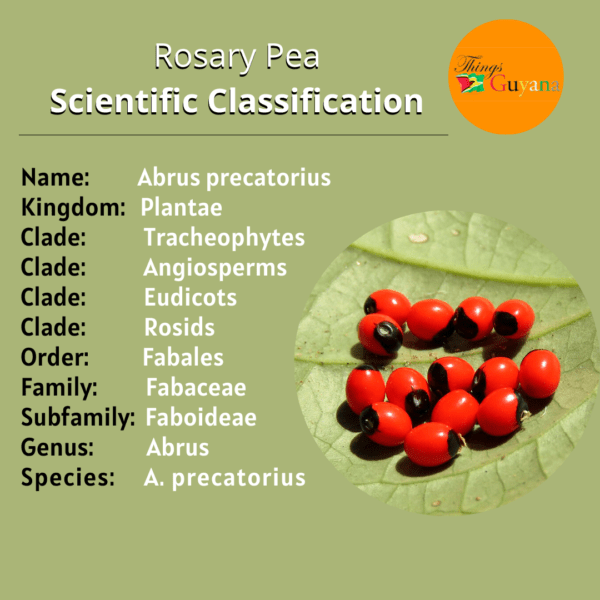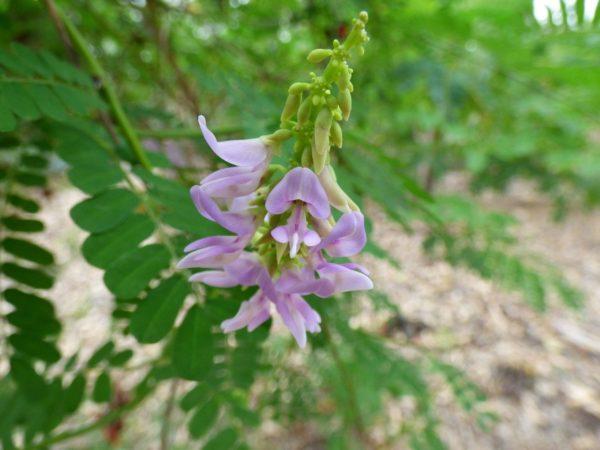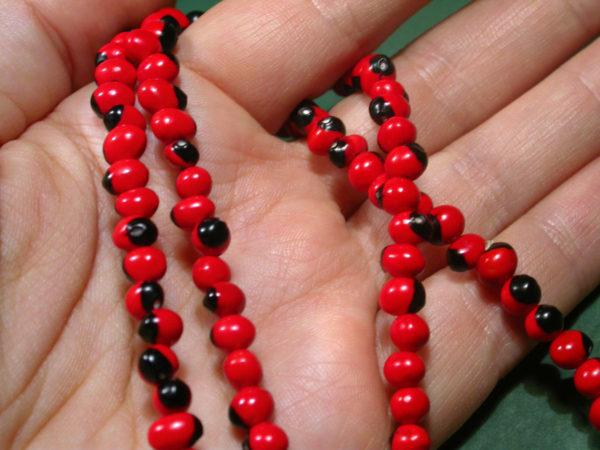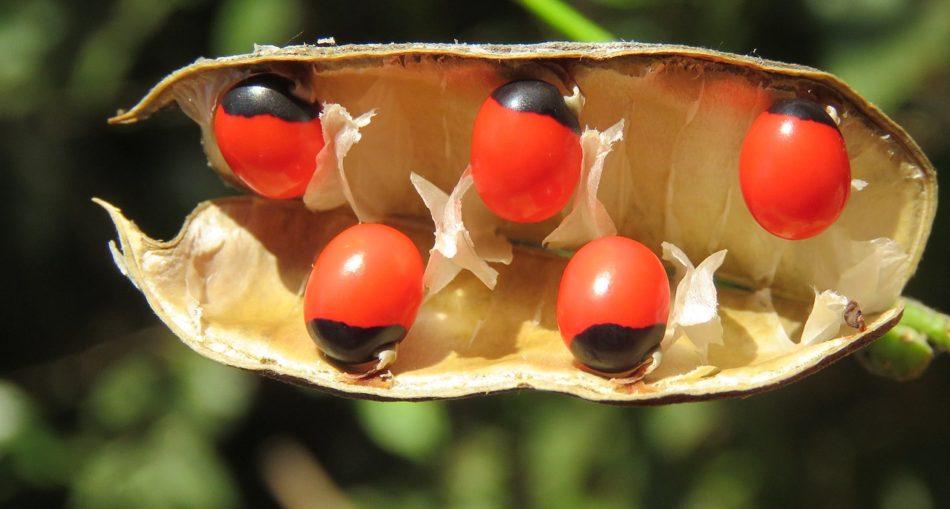When walking to nursery school at the ripe age of around 3 years old I recall always asking my mother to stop by the bushes with these lovely red ‘beans’ (I called them), of course, I would not always be given permission to stop and pick them but when I did get the chance I would be so elated to collect them and go home so we could string them into beads and wear them around my hand or I would sometimes even put them around my dolls as necklaces. These beads I had referred to as ‘red buck beads’ but, as I would later come to learn they are actually known as Rosary Peas or better known in the Caribbean as ‘Jumbie Beads‘.
Read more about the actual ‘Buck beads’ here: https://www.thingsguyana.com/jobs-tears-locally-known-as-buck-beads/

Description

Photo of Rosary Pea Flower. Photo Source: https://identify.plantnet.org/the-plant-list/species/Abrus%20precatorius%20L./data
These peas are shiny and bright red with a black spot on one of the ends and if you hold up two of them, just in the right way they might even resemble devilish eyes staring back at you. The plant is a climbing, invasive vine. The leaves are compound and may grow up to 5 inches (12.5 cm.) long. The flowers that bloom may be red, lavender, pink, or white.
Fun Fact: These peas may also seem as though they are edible, especially to children but they contain a deadly toxin named Abrin.
Habitat
These plants are native to Africa, Asia, Australia, and the Pacific region but have been introduced to other locations including Florida and Hawaii. The plant is highly invasive and loves to grow in warm temperatures and as such takes up most of the tropical regions in both hemispheres of the earth.
Fun Fact: Because they are brightly coloured birds would usually snack on them and as such, they ended up becoming widely spread throughout the Caribbean.
Toxicity
As was mentioned previously, rosary pea contains a deadly toxin known as abrin. Arbin has been compared to ricin but it is potentially more dangerous. Powdered abrin is yellowish in colour. Abrin is a stable material, which means that it can withstand harsh environmental conditions like extremely hot or extremely cold temperatures for an extended period of time. Whether abrin is ingested, breathed in, or injected it can have severe side effects. Abrin attacks the inside of cells and prevents the cells from making the necessary proteins that the body requires.
Uses Of Rosary Pea
Jewellery Making
These beads have been used for decades to create beautiful pieces of jewelry, especially around the Caribbean as a way to ward off ‘bad eye’ or evil eye. To ward off jumbies, or malevolent spirits, and “mal-yeux,” or the evil eye, vividly colored seeds are strung into bracelets and worn around the wrist or ankle in Trinidad, a country in the West Indies.

Rosary Pea Seeds Made Into Necklace. Photo Source: https://commons.wikimedia.org/wiki/File:Abrus_precatorius,_threaded_seeds.jpg
They can also be strung into rosaries which are pieces of jewellery, particularly a necklace that is used for religious purposes. The beads are counted as prayer is being recited. Many major religions such as Hinduism, Buddhism, Christianity, and Islamic faith use rosaries.
Making Instruments
These peas have been used to make certain percussion instruments that were played long ago. They can also be used in Shak-Shaks.
Unit Of Measurement
In India, it was used as a form of measurement known as ‘Ratti’, it was used to weigh gold where 8 ratti will be equivalent to 11.6 grams of gold.
For A Weapon
Yes, This tiny, seemingly harmless red seed can be used as a weapon. In the late 1800s, it has been recorded that the rosary pea was used in order for certain natives in India to secure hide (the skin of large animals, notably that of cattle.) The process was documented in the King’s American Dispensatory in 1898 goes as follows:
- The seeds were cracked opened using stones and then soaked in water for about ten minutes.
- Afterward, the seeds were grounded into a paste ad roller dup into a sharp-ended, one-inch cone.
- They were then placed under moderate heat of the sun where they would become hardened once more.
- The seed was placed on top of needles to be used as a method of puncturing through the skin of cattle. Within less than 2 days the cattle will die without leaving a trace.
Traditional Medicine
- For centuries, within regions of Southern India, this seed has been made into an oil and used as a supposed aphrodisiac.
- Tea is made from leaves and used for fevers, coughs, and colds.
- Although they are a little bitter, the roots of this plant are used as a substitute for licorice in India.
Literary Mention
It is speculated that the poem “One-Hearted” by Wang Wei which was written during the tang dynasty refers to these seeds as “red berries.”
When those red berries come in springtime,
Flushing on your southland branches,
Take home an armful, for my sake,
As a symbol of our love.– Wang Wei
Fun Facts
- Because of the plant’s fast growth, hard-shelled seeds, and propensity to sucker, their deep roots make them very difficult to get rid of, and they also make it very difficult to avoid re-infestation.
- To remove the toxins from the seeds the ancient Indians would have to boil them in milk and then have them dried before they can be used in any form of consumption.
References:
- https://en.wikipedia.org/wiki/Abrus_precatorius
- https://emergency.cdc.gov/agent/abrin/basics/facts.asp
- https://www.homequestionsanswered.com/what-is-a-rosary-pea.htm#:~:text=Abrus%20precatorius%20seeds%20are%20used,and%20to%20help%20stimulate%20labor.
- https://hellopoetry.com/poem/14720/one-hearted/







